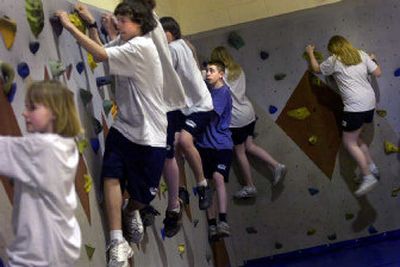An ‘A’ for activity

Rebekah Danner didn’t need an expensive gym membership to get fit.
The 14-year-old just showed up for her physical education class each day at Glover Middle School, losing 4 percent of her body fat.
“I don’t really do, like, sports,” Danner said. “But I like to be active.”
Spokane Public Schools’ physical fitness curriculum called “Fit for the Future” encourages students like Danner to keep moving by strapping heart-rate monitors to their wrists. A percentage of their grade is based on how long students remain “in the zone.”
The schools also encourage students to try as many different activities as possible, recognizing that not everyone has athletic skill. Teachers have introduced students to rollerblading, snowshoeing, indoor climbing, and Frisbee golf. They preach wellness and encourage students to have goals.
“We teach very few skills,” said Glover teacher Pam Crowley. “We just want every student to have fun, to move more.”
The district’s innovative curriculum has been so successful that other districts around the state are looking to duplicate it.
The school board approved a purchase and license agreement last week to let allow Spokane to sell its copyrighted fitness and health curriculum to other state districts.
Districts with an enrollment of 1,000 or less will pay $700 for the materials to implement the program in their schools. Larger districts would pay 70 cents per full-time equivalent student. That would mean a $21,000 fee for a district of 30,000 kids.
So far 12 districts have purchased the materials, two large districts in western Washington have expressed interest, and one school is piloting it this year, said Karen Cowan, health and fitness coordinator for the district. The money will be used to maintain fitness equipment already in place at most district schools.
Aided by a $1.2 million grant from the Department of Education, the new curriculum has been implemented over the past four years. Money was used to purchase equipment, including state-of-the-art gym equipment for fitness centers at all middle and high schools, and heart-rate monitors in all schools.
They still play volleyball and soccer, but the focus is to keep moving, not on athletics.